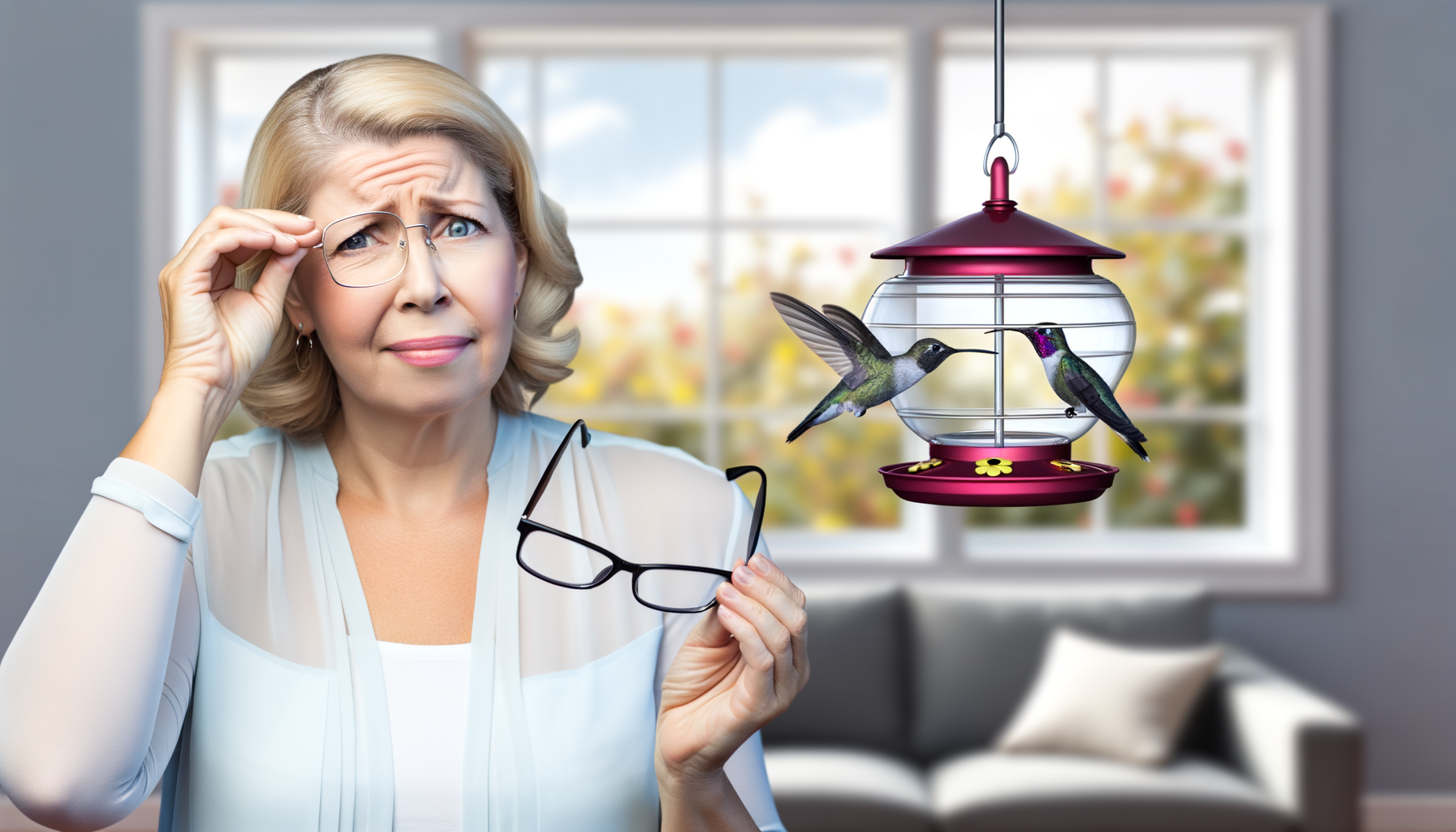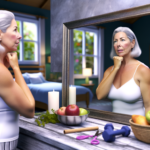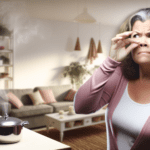Understanding Double Vision (Diplopia)
Double vision, medically known as diplopia, is a condition where an individual sees two images of a single object. This visual impairment can be temporary or persistent, and it may affect one eye (monocular) or both eyes (binocular). Diplopia can be a symptom of various underlying health issues, ranging from minor conditions to more serious health concerns.
Prevalence and Causes of Double Vision
While the exact prevalence of double vision is not well-documented, it is known to occur across all age groups and can be caused by a variety of factors. These include eye muscle problems, nerve conditions that affect eye movement, brain issues such as stroke or trauma, and systemic diseases like diabetes. In some cases, the cause of double vision can be difficult to pinpoint without a thorough medical evaluation.
Menopause: Hormonal Changes and Vision Effects
Menopause is a natural biological process that typically occurs between 45 and 55 years of age, marked by the end of menstrual cycles due to declining oestrogen levels. These hormonal changes can have widespread effects on the body, including the eyes. Symptoms such as dry eyes, changes in vision, and discomfort with contact lenses are commonly reported. Additionally, conditions like presbyopia, the loss of the eye’s ability to focus on close objects, may become more pronounced during this time.
The Link Between Menopause and Eye Health
The relationship between menopause and eye health is complex. Hormonal fluctuations can lead to changes in the tear film and ocular surface, contributing to dry eye syndrome and visual discomfort. Moreover, menopause has been associated with an increased risk of developing cataracts and glaucoma, both of which can contribute to double vision. It is essential for menopausal women to be aware of these potential changes and to seek regular eye care to maintain optimal vision health.
Understanding the impact of menopause on eye health is crucial for early detection and management of symptoms. By recognizing the signs and seeking appropriate care, women can better navigate the visual challenges that may accompany this stage of life.
Medical Perspective on Double Vision During Menopause
Hormonal Fluctuations and Visual Symptoms
Menopause is a significant period in a woman’s life marked by the end of menstrual cycles and a decrease in the production of hormones such as estrogen and progesterone. These hormonal fluctuations can lead to a variety of symptoms, including visual disturbances. Estrogen is known to influence the moisture levels of mucous membranes, including those in the eyes, potentially leading to dryness and discomfort. Additionally, changes in hormone levels can affect the shape and pressure within the eye, sometimes resulting in double vision or diplopia. It is essential to understand that while some visual symptoms may be temporary, others could signal more serious conditions.
Common Eye Conditions in Menopause
During menopause, women may experience several eye conditions that can affect their vision. Dry eyes are prevalent due to decreased tear production and quality, leading to irritation and blurred vision. Cataracts, a clouding of the eye’s lens, and glaucoma, characterized by increased intraocular pressure, are also concerns. These conditions can contribute to double vision and require careful monitoring and management.
When to Seek Medical Attention
It is crucial to seek medical attention if you experience persistent double vision or any significant changes in your eyesight. Other symptoms warranting a visit to an eye care professional include:
- Redness or pain in the eyes
- Sensitivity to light
- Seeing halos around lights
- Loss of peripheral vision
- Any sudden changes in vision
These symptoms could indicate serious eye conditions that might require immediate treatment to prevent long-term damage.
Diagnostic Approaches and Treatments
Diagnosing the cause of double vision during menopause involves a comprehensive eye examination. An optometrist or ophthalmologist will assess visual acuity, eye pressure, and the health of the eye’s internal structures. They may also perform tests to evaluate the tear film and the function of the eye muscles. Treatment options vary depending on the underlying cause and may include:
- Lubricating eye drops or artificial tears for dry eyes
- Prescription medication to manage conditions like glaucoma
- Corrective lenses or prism glasses to address refractive errors
- Surgery for cataracts or other structural issues
In some cases, hormone replacement therapy may be discussed, but its benefits and risks must be carefully weighed, especially concerning eye health. An interdisciplinary approach, including regular consultations with healthcare providers, is often the most effective way to manage double vision and other menopausal symptoms.
Natural Management of Double Vision
Lifestyle Modifications for Eye Health
Maintaining eye health during menopause can be supported by adopting certain lifestyle habits. Protecting your eyes from the sun is crucial; always wear sunglasses with 100% UV protection. Resting your eyes regularly, especially when doing extensive screen work, can prevent strain. Placing your hands over your eyes for a few seconds of darkness can be beneficial. Avoiding smoking is also important, as tobacco can negatively impact eye health. Additionally, staying hydrated is vital, as dehydration can contribute to dry eyes and blurred vision.
Eye Exercises to Improve Vision
Eye exercises may help strengthen the muscles around your eyes and improve vision. One such exercise involves looking up as far as possible, then slowly rotating your eyes clockwise, tracing the edges of your field of vision. Repeat this counterclockwise. Perform this exercise up to 10 times, several times a day. Another helpful practice is to gently massage the eyes, moving inwards towards the nose over the top of the eye and gently outwards towards the ear under the eye.
Dietary Considerations and Supplements
A diet rich in vitamin A/beta-carotene is beneficial for eye health. Include foods like cantaloupe, carrots, sweet potatoes, squash, and tomatoes in your meals. Supplements that support eye health include alpha-lipoic acid, bilberry, vitamin E, eyebright, vitamin A, glutathione, lutein, zeaxanthin, rutin, and quercetin. Omega-3 fatty acids, found in fish oils, along with zinc, vitamin C, and vitamin E, are also essential for maintaining healthy eyes. A phytoestrogen supplement may help manage hormonal fluctuations that can affect vision.
Alternative Remedies and Their Efficacy
Alternative remedies such as heated eye pads can provide comfort, especially if your eyes feel tired and blurry by the evening. The use of Sea Buckthorn Oil supplements may help with dry eyes. While these remedies can offer relief, their efficacy varies from person to person. It’s important to consult with a healthcare provider before starting any alternative treatments to ensure they are appropriate for your specific condition and overall health.
Implementing these natural management strategies can help alleviate double vision and support eye health during menopause. However, if vision problems persist or worsen, it is crucial to seek professional medical advice.
By the way, something for you, a little gift!!!
I am just in the middle of publishing my book. It’s about How women can balance their hormones. One part is about food and diet, of course.
Follow this link and enter your email.
I will send you this part of the book for free once the book is published. It has many concrete, practical tips and recipes and will help you feel better during menopause or times of Big hormonal fluctuations.
Annette, Damiva Lead for Health & Wellness

Impact of Double Vision on Daily Life
Challenges in Daily Activities
Double vision, or diplopia, can significantly disrupt the routine activities of those experiencing it. For women going through menopause, this symptom can add to the already challenging array of physical changes. Tasks that require sharp vision, such as reading, writing, driving, and even walking, can become difficult and frustrating. The loss of depth perception can lead to misjudging distances, increasing the risk of accidents and falls. Moreover, activities that were once performed with ease, like threading a needle or applying makeup, may now require additional time and effort, or may become nearly impossible without assistance.
Psychological and Emotional Considerations
The onset of double vision can also have profound psychological and emotional effects. It can lead to feelings of anxiety and uncertainty about one’s health, especially when the cause is initially unknown. The frustration of dealing with a compromised vision can contribute to stress and depression, particularly if it impedes one’s independence or interferes with work and social activities. The fear of experiencing double vision in public can also lead to social withdrawal and isolation, further impacting mental health.
Adaptive Strategies and Aids
To cope with double vision, various adaptive strategies and aids can be employed. One common method is the use of an eye patch to cover one eye, which can help to eliminate the double image. For those who require a less conspicuous solution, special glasses with prisms or an occlusive lens can be prescribed by an optometrist. These glasses help to realign the images seen by each eye, reducing the effect of diplopia.
Additionally, making environmental modifications can assist in managing double vision. Increasing lighting in the home can help to reduce strain on the eyes, and using high-contrast colors for important items can make them easier to distinguish. For computer work, screen magnification software and adjusting the monitor settings to reduce glare can be beneficial.
It is also important to organize and simplify one’s living space to prevent accidents. This includes securing rugs, clearing walkways of obstacles, and using non-slip mats in the bathroom. For reading and close work, magnifying tools or electronic devices can be used to enlarge text and images.
Lastly, support from family, friends, and support groups can provide emotional comfort and practical assistance. Sharing experiences with others who understand the challenges of double vision can be a valuable resource for coping strategies and encouragement.

Preventive Measures and Early Detection
Regular Eye Examinations
One of the most effective strategies for preventing vision problems, including double vision, is to engage in regular eye examinations. As women approach and enter menopause, their eyes can be affected by hormonal changes, making it crucial to monitor eye health closely. An annual comprehensive eye exam can help detect early signs of eye conditions such as dry eye syndrome, glaucoma, and cataracts, which are more prevalent during menopause. These exams allow for early intervention, which can significantly improve the prognosis and management of these conditions.
Monitoring Hormonal Health
Hormones play a pivotal role in regulating various bodily functions, including eye health. Monitoring hormonal health is essential, especially during menopause, when levels of estrogen and progesterone fluctuate. These hormonal changes can lead to dry eyes, changes in the cornea’s elasticity, and even affect the eye’s oil glands. Women should discuss any vision changes with their healthcare provider, who may recommend hormone replacement therapy or other treatments to alleviate symptoms. Additionally, being aware of thyroid hormone levels is important, as imbalances can lead to eye conditions such as thyroid eye disease.
Awareness and Education on Vision Changes
Education is a powerful tool in the early detection and prevention of vision issues. Women should be aware of the potential vision changes that can occur during menopause, such as sensitivity to light, blurry vision, and the need for more frequent changes in prescription lenses. Understanding these changes can prompt timely medical advice and treatment. Resources such as patient advocacy groups, informational websites, and healthcare providers can offer valuable information on how menopause may impact eye health. By staying informed, women can take proactive steps to maintain their vision and overall eye health during this significant life transition.
In conclusion, preventive measures such as regular eye examinations, monitoring hormonal health, and staying informed about the potential vision changes during menopause are critical for maintaining eye health. Early detection of eye conditions can lead to more effective treatments and a better quality of life for women experiencing menopause.
The Role of Healthcare Providers
Optometrists and Ophthalmologists: Roles and Responsibilities
Optometrists and ophthalmologists play a critical role in the management of double vision during menopause. Optometrists are primary healthcare professionals who perform eye exams, prescribe corrective lenses, and diagnose various eye conditions. Ophthalmologists are medical doctors who specialize in eye and vision care, including performing eye surgery, diagnosing and treating eye diseases, and prescribing medication.
Both optometrists and ophthalmologists are responsible for:
- Conducting comprehensive eye examinations to detect changes in vision and eye health.
- Prescribing corrective lenses or eye exercises to manage double vision.
- Identifying underlying causes of double vision, which may be related to hormonal fluctuations during menopause.
- Referring patients to other healthcare professionals when systemic conditions are suspected.
- Providing patient education on eye health maintenance and the impact of menopause on vision.
Interdisciplinary Approach to Menopausal Symptoms
An interdisciplinary approach is essential for managing menopausal symptoms, including double vision. Healthcare providers, including gynecologists, endocrinologists, and primary care physicians, should collaborate to offer comprehensive care. This team-based approach ensures that:
- Menopausal symptoms are evaluated holistically, considering the potential impact on eye health.
- Patients receive consistent information and guidance on managing menopause-related changes.
- There is coordination in the treatment plans, especially when hormonal therapy may affect vision.
Patient Advocacy and Support Networks
Healthcare providers must advocate for their patients by:
- Ensuring patients have access to accurate information about menopause and its effects on vision.
- Encouraging patients to share their concerns and symptoms without hesitation.
- Guiding patients towards support networks, including menopause support groups and counseling services.
- Empowering patients to make informed decisions about their eye health and overall well-being during menopause.
By taking an active role in patient advocacy and support, healthcare providers can help women navigate the challenges of menopause and double vision with confidence and knowledge.
Conclusion: Navigating Double Vision in Menopause
Throughout this article, we have explored the intricate relationship between menopause and double vision, a condition medically known as diplopia. Menopause, characterized by a decline in estrogen and progesterone levels, can lead to a myriad of symptoms, including those affecting eye health. The prevalence of dry eye syndrome and other visual disturbances increases during this phase, potentially contributing to the onset or exacerbation of double vision.
Medical perspectives have highlighted the role of hormonal fluctuations in visual symptoms, with common eye conditions in menopause including dry eyes, cataracts, and age-related macular degeneration. Diagnostic approaches range from comprehensive eye examinations to more specialized tests to determine the underlying cause of diplopia, leading to treatments that may include lubricating eye drops, hormone replacement therapy, and vision therapy.
Natural management strategies, such as lifestyle modifications, eye exercises, dietary considerations, and alternative remedies, have been discussed as adjuncts to medical treatment. These can help mitigate symptoms and improve overall eye health.
Encouragement for Ongoing Management and Support
Living with double vision can significantly impact daily life, presenting challenges in performing routine activities and affecting psychological well-being. It is crucial for individuals experiencing these symptoms to seek ongoing support and management. Healthcare providers play a vital role in patient advocacy, offering resources and support networks to help navigate the complexities of menopause-related visual changes.
Patients are encouraged to maintain regular eye examinations and monitor hormonal health to detect any changes early. Awareness and education on potential vision changes during menopause can empower women to take proactive steps in managing their eye health.
Future Directions in Research and Treatment
While current treatments provide relief for many, there is still much to learn about the pathophysiology of double vision in menopause. Future research should focus on understanding the precise mechanisms by which hormonal changes affect the visual system and identifying new treatment modalities that address these specific changes.
Interdisciplinary research, combining the expertise of optometrists, ophthalmologists, endocrinologists, and neurologists, is essential to develop comprehensive treatment approaches. Additionally, advancements in telemedicine and patient education can improve access to care and support for women experiencing menopause-related double vision.
In conclusion, navigating double vision during menopause requires a multifaceted approach that includes medical treatment, lifestyle adjustments, and supportive care. With continued research and patient-centered care, we can improve the quality of life for those affected by this condition.


















